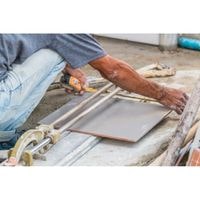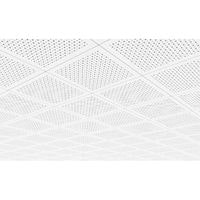How to cut ceiling tiles. Mineral fiber ceiling tiles and fiberglass ceiling tiles can get dirty, stained, or just start to look old after a few years.
If you’re tired of looking at your old ceiling tile, or if you just want to replace the stained ones, it’s not hard to swap out your ceiling tiles in a matter of hours.
Measure the size of the tile you need to fill in any gaps in the ceiling grid and use a utility knife to cut each new tile to size.
The last thing you need to do is make a shadow line on one side of each new tile before installing it into the floor grid.
Not only do you have a whole new, fresh perspective on things with shiny white ceiling tiles instead of your grey ones that were there before, but your home will also feel brighter and cleaner.
Hire an electrician if necessary for electrical updates as needed.
How to cut ceiling tiles

All types of ceiling tiles can be cut with basic hand tools. Acoustic tiles are generally lightweight and semi-soft, making them a better candidate for cutting with a carpet knife or scissors.
Drywall-like drop ceiling (suspended ceiling) tiles, which can be made of either metal or drywall, are cut with a utility knife.
As for marking cuts on the tile in order to achieve even spacing between panels when installing your new ceiling tiles?
It helps to have a framing square or a drywaller’s T-square so you can make sure you’re at the right angle mark down your spots before scoring the tile with your blade or your utility knife in order to avoid cracking it.
Cut Acoustic Tiles

Acoustic tiles for drop-ceiling and surface-mount applications are easy to cut with a hot knife.
A hot knife cuts deeper and more cleanly than most standard utility knives can, making it user-friendly and helpful in multiple ways.
It is recommended that you wear flexible gloves when working with acoustic tiles so as to maintain the quality of the product.
While not compromising your own safety by potentially harming yourself and/or damaging your hands by rubbing against the sharp edges of the acoustic tile itself.
Draw a line for the cutting
1. Lay a scrap of material similar to that of your work surface on the work area to be saved from the effects of the knife’s blade edge, with such a protector positioned for the size and shape of the tile being cut.
2. Place the tile face-up on top of the material, again taking care to measure across it carefully and marking with a light pencil at edges (at top and bottom this time)
Making the Cut
Place the T-square on top of the tile so that it’s perfectly lined up with a line that you wanted cut. Hold onto it firmly with one hand and then score the tile carefully using a carpet knife.
You can typically run the knife blade all along the edge of the T-square until you’ve cut through the tile entirely.
Cut out a circular shape
You can make circular cutouts in ceiling tiles with a rotary tool, a hole saw, or a carpet knife.
First, measure and mark the center of the ceiling tile and then draw a circle around it that is approximately one inch in diameter (using an actual carpenter’s compass would be ideal for this task).
Next, using whichever method you have chosen, cut out the center of the ceiling tile. To do so with a carpet knife or a rotary tool, hold them upright while cutting to ensure the blade is standing vertical to the face surface of the tile.
The hole saw can be attached to a drive bit or portable drill; following the instructions accordingly based on what you have chosen. It’s better to cut along all lines at once instead of drilling small holes first.
Threaded pieces may break off if they are not aligned correctly in your ceiling frame! Once complete leave any maintenance needed later after everything else is completed.
How to Cut Drop-Ceiling Tiles (Drywall)

Drop ceiling tiles are essentially drywall with vinyl facing, which is why they can be cut just like drywall.
Use a saw to make straight cuts, and a keyhole saw to make curved ones. A rotary tool makes cutting circular holes quick work of the job.
Draw the cutting line
First, you will want to place your tile face-up on the table. Measure across the tile and make a mark with a ruler at each of its top edges and its bottom edge.
Taking the Cut
Using a framing square, place it against a tile so that one of its sides is aligned with the mark you have made.
Firmly hold the framing square in position with one hand, then make a deep score along this side of the framing square using a small hand saw or utility knife.
Completing the cut
Put the tile up against the edge and make sure it is properly aligned. Make sure your scored line is facing up. Then press down firmly over the waste material so that you can snap it along this scored line.
Angle your tile upward slightly, then cut through the drywall back paper along the crease to complete your cut.
After cutting your tile, lay it flat and trim off any peaks of the core if necessary by going gradually and parallel to your cut line until they are flush with and visually indistinguishable from the surface of your wall tile underneath.
Cut a circular shape
Making circular cutouts can be done with a wide variety of tools, such as drills and drywall saws.
If a drill is all that you have available, set the tip of the drill bit against the tile edge, and slowly grind along the line circumference until the hole is complete.
When using a rotary tool for this task, layout pencil marks at half-inch increments around an ‘X’. Stay inside these markings when using your tool to create gradual gouges in the tile.
Once these divots are deep enough, gradually move closer to an iteration’s center point by about two inches until there is only sufficient material left for the hole itself.
How to cut ceiling tiles
Related Guides
